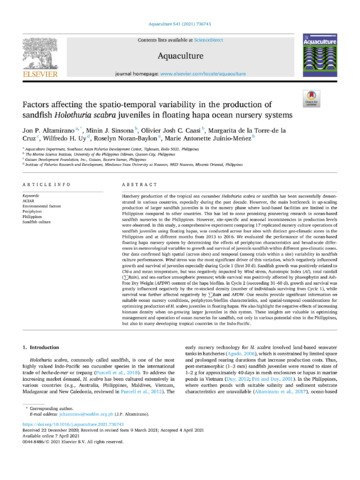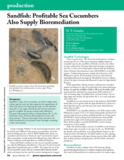Factors affecting the spatio-temporal variability in the production of sandfish Holothuria scabra juveniles in floating hapa ocean nursery systems
- Global styles
- MLA
- Vancouver
- Elsevier - Harvard
- APA
- Help

View/
Date
2021-04Author
Page views
2,159ASFA keyword
AGROVOC keyword
Taxonomic term
Metadata
Show full item record
Share
Abstract
Hatchery production of the tropical sea cucumber Holothuria scabra or sandfish has been successfully demonstrated in various countries, especially during the past decade. However, the main bottleneck in up-scaling production of larger sandfish juveniles is in the nursery phase where land-based facilities are limited in the Philippines compared to other countries. This has led to some promising pioneering research in ocean-based sandfish nurseries in the Philippines. However, site-specific and seasonal inconsistencies in production levels were observed. In this study, a comprehensive experiment comparing 17 replicated nursery culture operations of sandfish juveniles using floating hapas, was conducted across four sites with distinct geo-climatic zones in the Philippines and at different months from 2013 to 2016. We evaluated the performance of the ocean-based floating hapa nursery system by determining the effects of periphyton characteristics and broad-scale differences in meteorological variables to growth and survival of juvenile sandfish within different geo-climatic zones. Our data confirmed high spatial (across site) and temporal (among trials within site) variability in sandfish culture performances. Wind stress was the most significant driver of this variation, which negatively influenced growth and survival of juveniles especially during Cycle 1 (first 30 d). Sandfish growth was positively related to Chl-a and mean temperature, but was negatively impacted by Wind stress, Autotropic Index (AI), total rainfall (∑Rain), and sea-surface atmospheric pressure; while survival was positively affected by phaeophytin and Ash-Free Dry Weight (AFDW) content of the hapa biofilm. In Cycle 2 (succeeding 31–60 d), growth and survival was greatly influenced negatively by the re-stocked density (number of individuals surviving from Cycle 1), while survival was further affected negatively by ∑Rain and AFDW. Our results provide significant information on suitable ocean nursery conditions, periphyton/biofilm characteristics, and spatial-temporal considerations for optimizing production of H. scabra juveniles in floating hapas. We also highlight the negative effects of increasing biomass density when on-growing larger juveniles in this system. These insights are valuable in optimizing management and operation of ocean nurseries for sandfish, not only in various potential sites in the Philippines, but also in many developing tropical countries in the Indo-Pacific.
Suggested Citation
Altamirano, J., Sinsona, M., Caasi, O. J., de la Torre-de la Cruz, M., Uy, W., Baylon, R., & Juinio-Meñez, M. A. (2021). Factors affecting the spatio-temporal variability in the production of sandfish Holothuria scabra juveniles in floating hapa ocean nursery systems. Aquaculture , 541, 736743. https://doi.org/10.1016/j.aquaculture.2021.736743
Type
ArticleISSN
0044-8486Collections
- Journal Articles [1258]
Related items
Showing items related by title, author, creator and subject.
-
Aquaculture breeding enhancement: Maturation and spawning in sea cucumbers using a recombinant relaxin-like gonad-stimulating peptide
Chieu, Hoang Dinh; Turner, Luke; Smith, Meaghan K.; Wang, Tianfang; Nocillado, Josephine; Palma, Peter ; Suwansa-ard, Saowaros
; Suwansa-ard, Saowaros  ; Elizur, Abigail; Cummins, Scott F. (Frontiers Media, 2019-02-19)
Wild sea cucumber resources have been rapidly exhausted and therefore there is an urgent need to develop approaches that will help restocking. Currently, there is a lack of information regarding the genes involved in sea ...
; Elizur, Abigail; Cummins, Scott F. (Frontiers Media, 2019-02-19)
Wild sea cucumber resources have been rapidly exhausted and therefore there is an urgent need to develop approaches that will help restocking. Currently, there is a lack of information regarding the genes involved in sea ... -
Growth pattern of the tropical sea cucumber, Holothuria scabra, under captivity
Watanabe, Satoshi; Sumbing, Joemel; Lebata-Ramos, Ma. Junemie Hazel (Ministry of Tropical Agricultural Research Centre, 2014)
The growth of the juvenile sea cucumber, Holothuria scabra, was studied under captivity to elucidate the growth variation pattern and determine the best-fit growth model to estimate age- and size-specific growth rates. ...
(Ministry of Tropical Agricultural Research Centre, 2014)
The growth of the juvenile sea cucumber, Holothuria scabra, was studied under captivity to elucidate the growth variation pattern and determine the best-fit growth model to estimate age- and size-specific growth rates. ... -
Sandfish: Profitable sea cucumbers also supply bioremediation
Castaños, Milagros T.; Ledesma, Rossea V.; Corre, Kaylin G.; de Jesus-Ayson, Evelyn Grace (Global Aquaculture Alliance, 2011)Sandfish, a type of sea cucumber, are both a high-value culture species and one that supports the aquaculture of other fish species by cleaning up waste on the bottoms of ponds or sea cages. Hatchery and nursery technologies ...





